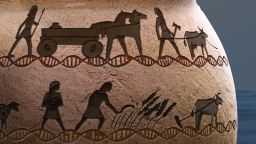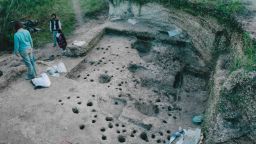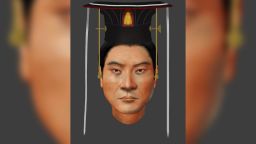George Washington family secrets revealed by DNA from unmarked 19th century graves

Sign up for CNN’s Wonder Theory science newsletter. Explore the universe with news on fascinating discoveries, scientific advancements and more.
Genetic analysis has shed light on a long-standing mystery surrounding the fates of President George Washington’s younger brother Samuel and his kin. Two of Samuel’s descendants and their mother were recently identified from skeletal remains found in unmarked burials dating back to the 1880s. The investigation also provided the first patrilineal DNA map for the first US president, who had no children of his own.
Researchers pinpointed key ancestry details through several types of DNA analysis, including a new technique that analyzed tens of thousands of points of genomic data called single nucleotide polymorphisms, or SNPs, which are variations in the genetic sequence affecting just one nucleotide, a building block of DNA.
Another key component was DNA from a living descendant of Samuel Washington. By comparing the descendant’s pristine DNA with degraded, centuries-old DNA in bone fragments, the scientists uncovered clues about long-lost identities and connections in the Washington family, researchers reported Thursday in the journal iScience.
“The multitude of these methods allowed us to reveal relationships between unidentified human remains from the mid-19th century and a living descendant who was several generations removed from his ancestors,” said senior study author Charla Marshall, a molecular anthropologist and deputy director of the US Department of Defense DNA Operations, in an email.
These techniques could also help identify unknown remains from people who served in the military, going as far back as World War II, according to the study.
Buried in unmarked graves
Samuel Washington, more than two years younger than George, died in 1781 and was buried in the cemetery at his Harewood estate near Charles Town, West Virginia. Records showed that Harewood cemetery held 20 members of the Washington family, “including Samuel Washington and two of his wives, their children, grandchildren, and great-grandchildren, among others,” said lead study author Courtney L. Cavagnino, a research scientist with the US Armed Forces DNA Identification Laboratory.
But unlike George Washington, who is interred in a magnificent marble tomb in Mount Vernon, Virginia, Samuel’s grave was unmarked, likely to protect it from grave robbers, Cavagnino told CNN in an email. Other graves also lacked headstones, leaving modern historians uncertain about who was buried where.

Researchers excavated five unmarked graves at the cemetery in 1999 in an effort to find Samuel Washington’s resting place. They recovered small bones and teeth from three burials, but DNA testing at the time was inconclusive, with the samples badly degraded and contaminated with bacteria.
Fortunately for the authors of the new study, “DNA analysis has come a long way since the early 2000s,” Cavagnino said. They combined techniques that optimized the shortened strands of damaged DNA from the remains, allowing them to extract the genetic material they needed. Maternal relationships were determined through mitochondrial DNA sequencing, while paternal relationships were found by looking at Y chromosomes. Further details came from 95,000 SNPs, an enormous volume of data targeting autosomal DNA (DNA that isn’t attached to sex chromosomes).
Genetic data first established that the remains were a woman and her two sons; records further clarified that the woman was Lucinda “Lucy” Payne, and the males were Samuel’s grandsons (and George’s grandnephews): George Steptoe Washington Jr. and Dr. Samuel Walter Washington. The living descendant’s DNA was a closer match to that of Dr. Samuel Walter Washington.
Not only did this data establish that the deceased doctor was the living Washington’s great-great-grandfather, it also showed which remains belonged to which brother, which would otherwise have been impossible to establish with certainty, the scientists said.
Recovered identities
In 1882, the remains of several people had been disinterred from Harewood and moved to graves at Zion Episcopal Church in Charles Town. Among them were Lucy Payne and her sons. But some of their bones were left behind; by the time the 1999 excavation recovered them, it was unclear to whom they belonged. Now, nearly 150 years later, the identities of those remains have finally been settled.
“The combination of deceased and living relatives made this study a wonderful puzzle, where you had to work hard to figure it out but you had all the necessary pieces,” said Connie J. Mulligan, a professor in the department of anthropology and coordinator of the Genetics and Genomics Graduate Program at the University of Florida. Mulligan, who studies genetic variations to understand how DNA shapes health and disease, was not involved in the research.
The living descendant, Samuel Walter Washington, who is the current owner of Harewood estate, turned out to have more DNA in common with the two deceased brothers than the researchers expected. They attributed this to pedigree collapse — when marriages between relatives shortens the number of ancestors — caused by multiple cross-cousin marriages in the Washington family tree.
“The cross-cousin marriages impacted only the brothers’ kinship relationships and not their mother’s, who married into the family,” Mulligan told CNN. “I don’t know of any study that’s had a dataset as cool as this one, with the complexity in the pedigree so you could use empirical data to test how the interrelatedness changed the estimates of kinship relatedness.” The study, she added, “was a combination of cutting-edge science and great detective work!”
The researchers’ analysis also produced the first Y-chromosomal DNA profile for George Washington, as male individuals in the study — living and deceased — “were all direct paternal descendants of Augustine Washington, the father of George Washington,” Marshall said. This profile could clarify genealogical relationships among people who inherited the Washington surname but are uncertain of their familial connections “to determine who is paternally related to George Washington himself,” the study authors wrote.
But while the findings offer many new insights, the question that launched the 1999 excavation remains: Where is George’s brother buried? Samuel’s grave has not yet been discovered, nor have any of his remains been identified, according to Marshall. At this point, she added, his whereabouts may be lost for good.
“The search for Samuel Washington’s grave is no longer underway,” Marshall said. “It is possible that his grave was exhumed long ago, and may never be found again.”
Mindy Weisberger is a science writer and media producer whose work has appeared in Live Science, Scientific American and How It Works magazine.
2 comments



No comments:
Post a Comment